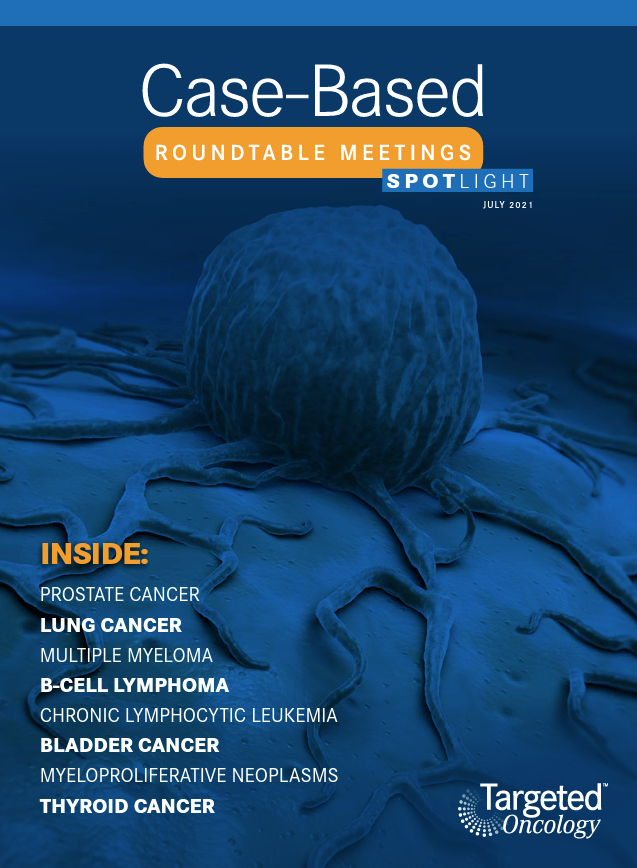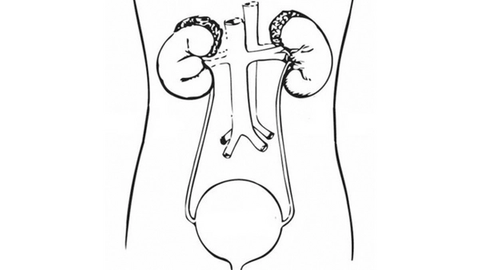RET Mutations in Medullary Thyroid Are Cancer Viable for Multiple Targeted Agents
Erminia Massarelli, MD, PhD, MS, discussed the case of a 58-year-old man with RET-mutant medullary thyroid cancer.
Erminia Massarelli, MD, PhD, MS

Erminia Massarelli, MD, PhD, MS, the codirector of the Lung Cancer and Thoracic Oncology Program, and associate clinical professor in the Department of Medical Oncology & Therapeutics Research at City of Hope, discussed the case of a 58-year-old man with RET-mutant medullary thyroid cancer (MTC).
Targeted OncologyTM: How would you treat a patient like the patient in this case?
MASSARELLI: When deciding whether to treat MTC, it’s very important to assess if the patient is symptomatic, the doubling time of the calcitonin and CEA, and [do mutation testing]. This decision is different than [those taken] in non–small cell lung cancer cases as it involves initiating treatment that potentially has adverse [events (AEs)] in patients that have a very high 10-year survival rate, which is 96% for patients with tumors that are confined to the thyroid gland.1 But unfortunately, for metastatic disease, the 10-year survival rate is only 40%. Therefore it is very important to determine whether or not to treat [the patient] as it’s going to be a chronic treatment.
RET mutations are present in 60% to 90% of [sporadic and germline] MTC cases.2 Up to 65% of sporadic cases have a RET mutation, and 16% of patients who lack the RET mutation have a RAS mutation.3 RET mutations are prognostic for a worse outcome. For example, patients with durable MTC and a RET mutation will likely have a recurrence even if they do not have multiple endocrine neoplasia type 2A and 2B. Therefore close follow-up of calcitonin and CEA levels and imaging is very important. Contrary to what happens with other cancers, with MTC there is very often an increase in calcitonin before imaging evidence of metastasis. The monitoring of these markers makes it easier to detect and follow patients who are progressing. For papillary thyroid carcinoma, RET fusions, a different type of gene alteration, are very important in 10% to 20% of cases.2

The National Comprehensive Cancer Network guidelines for asymptomatic MTC are to monitor and, if possible, treat the disease with RFA [radiofrequency ablation], embolization, or other regional therapies.4 Category 1 drugs for systemic therapy are vandetanib [Caprelsa] and cabozantinib [Cabometyx], and selpercatinib [Retevmo] and pralsetinib [Gavreto] are recommended for RET mutation–positive tumors. With tumor mutation burden–high disease [≥10 mut/Mb], pembrolizumab [Keytruda] may be useful. For symptomatic disease or in cases of disease progression, clinical trials are also an option. For these patients, the recommendations for systemic therapy are more or less the same. In addition, other small-molecule kinase inhibitors or dacarbazine can be used.
What is the evidence for using vandetanib in these cases?
The phase 3 ZETA trial [NCT00410761] compared vandetanib with placebo for advanced metastatic MTC.5 The trial included 331 patients with unresectable locally advanced disease, randomized to vandetanib [300 mg/ day] versus placebo. The response rate was 45% and the disease control rate was 87% for the vandetanib arm. The biochemical response was 69% for calcitonin and 52% for CEA. The data for the hazard ratio for overall survival [OS] were immature at the data cutoff point [HR, 0.89]. The hazard ratio for progression-free survival [PFS] was 0.46. The subgroup analysis of PFS according to RET status showed that patients with positive or unknown RET mutation status enjoyed the majority of the benefit, in particular those positive for the M918T mutation.
It is important to highlight that vandetanib is a multityrosine kinase inhibitor [TKI].6 It’s a very powerful VEGFR2 inhibitor and it has other targets including RET activity, which is lower. Therefore, the specificity of vandetanib is lower than that of specific RET inhibitors. In terms of toxicity, most AEs were reported in the vandetanib arm and the most common were diarrhea, rash, nausea, and hypertension.5 Thus it’s not an easy drug to manage. It also can cause QTC prolongation, so it requires EKG monitoring.
Can you discuss the use of cabozantinib in such cases? The phase 3 EXAM trial [NCT00704730] compared cabozantinib with placebo in 330 patients with rapidly progressing metastatic MTC.7 The randomization was 2:1 to cabozantinib [140 mg/day]. After 42 months of follow-up, the OS was 26 months versus 21 months for the placebo arm, which was not statistically significant. The median PFS was 11.2 months versus 4 months, and that difference was statistically significant.
However, in the subgroup analysis of the RET-positive mutations, the OS was very long: 44 months compared with 18.9 months in the placebo arm.7 The subgroup analysis showed that [patients who were] mutation positive had the majority of benefit, in particular [those who were] M918T positive. The RET-negative and RAS-positive subgroups did not have a significant advantage. AEs included diarrhea, decreased weight, decreased appetite, nausea, and fatigue. Cabozantinib is a multi-TKI as well, with VEGF and RET activity explaining the effectiveness against RET-mutant MTC.
Treatment discontinuation rates were high in both arms— 90% for cabozantinib and 100% for placebo—mainly due to disease progression.7 In the cabozantinib arm, AEs and serious AEs represented 22% of the reasons for discontinuation. Dose reduction occurred in 82% of patients for cabozantinib, of whom 46% underwent a second dose reduction. The AEs of cabozantinib are not easily managed, especially at such a high dose. In other diseases, such as renal cell carcinoma, cabozantinib is used at much lower doses [40 mg to 60 mg].8
What is the evidence for using selpercatinib? The phase 1/2 LIBRETTO-001 trial [NCT03157128] assessed the effectiveness of selpercatinib for RET-fusion-positive advanced or metastatic TC [non-MTC; n = 38] and RET point–mutational advanced or metastatic MTC [306 patients].9,10 Of these patients, 8 were naive for systemic therapy, 88 were cabozantinib/vandetanib–treatment naive, and 55 were previously treated with cabozantinib and vandetanib. RET mutations were detected in 143 patients: 57% M918T, 19% extracellular cysteine, 8% V804, and 16% other. The median age was 57 [previously treated] and 58 [treatment naive] years, and the ECOG performance status was mainly 0 to 1, with only a few patients with a performance status of 2. The median prior systemic regimens were 2 in the cohort of 55 patients that were previously treated, and 0 in the ones that were cabozantinib and vandetanib naive. Patients who had prior multikinase inhibitor treatment were equally distributed between either drug or both. Brain metastases rates were 7% in the previously-treated cohort and 2% in the naive cohort.
The response rate for RET-mutant MTCs was 69% [38 of 55 patients] in the previously treated group, and 73% [64 of 88 patients] in the treatment-naive group.10,11 The response rate for fusion-positive thyroid cancers was 79% in the previously treated group and 100% in the treatment-naive group. The median duration of response was not reached in patients with previously treated MTC, 22 months in treatment-naive MTC, 18.4 months in previously treated non-MTC, and not reached in treatment-naive non-MTC. Median PFS was not reached in previously treated MTC, 23.6 months in treatment-naive MTC, and 20.1 months in previously treated non-MTC.
Grade 3 treatment-related AEs [TRAEs] were reported at a rate of 28%, with the most frequent TRAEs being hypertension [12%], which is also common with vandetanib and cabozantinib; diarrhea [3%]; fatigue [1%]; and increase in liver function tests [(LFTs) 7% to 10%].10 The main grade 4 TRAE detected was an increase in LFTs. The dose reduction rate due to TRAEs was 30% and the discontinuation rate due to TRAEs was 2%; these were due to elevated alanine aminotransferase and drug hypersensitivity.
Describe the use of pralsetinib for a patient such as this. The phase 1/2 ARROW trial [NCT03037385] evaluated the effectiveness of pralsetinib for RET-mutant MTC in a multicenter study with 438 patients with advanced solid tumors, RET alterations, and an ECOG performance status of 0 or 1.12 Patients were treated with pralsetinib [400 mg/day] and were divided into 4 groups: RET-mutant MTC with prior cabozantinib and/or vandetanib [n = 67]; RET-mutant MTC without prior systemic treatment [n = 42]; RET-mutant MTC with prior systemic treatment other than cabozantinib and vandetanib [n = 10]; and other RET-altered solid tumors [n = 319]. The key end points were blinded, independent central review overall response rate, duration of response, and safety.
The median age was 59 years in the prior cabozantinib or vandetanib treatment cohort and 61 in the naive cohort.13 Most patients were male [69% and 72% for the prior treatment and treatment-naive groups, respectively] and White [78% and 76%, respectively]. The CNS [central nervous system] involvement rate was 7% in the prior cabozantinib or vandetanib–treated cohort and 14% in the naive cohort. The median number of prior therapies was 2, with a range of 1-7 in the prior cabozantinib or vandetanib group, and 28% of patients in the naive cohort had 3 or fewer prior therapies. Some patients in the naive cohort had also received anti–PD-1/PD-L1 kinase inhibitor therapy.
The efficacy response rate was 60% in previously treated cabozantinib or vandetanib patients and 66% in the naive cohort.13 The complete response rate was 1.8% in those previously treated with cabozantinib or vandetanib and 10% in the naive cohort. The partial response rate was 58% and 55% in the prior treatment and naive cohorts, respectively. The median duration of response was not reached for both cohorts, whereas the duration of response of 6 [or more months] was 79% and 84% in the prior treatment and naive cohorts, respectively. The most concerning grade 3/4 AE was hypertension, and other AEs were fatigue, pyrexia, dizziness, cough, and dysgeusia.
The FDA has approved pralsetinib for RET-altered thyroid cancers.13,14 Note that there is a tumor lysis syndrome [TLS] warning, as this was reported in patients with MTC receiving pralsetinib.13 Patients are at risk for TLS if they have rapidly growing tumors, high tumor burden, renal dysfunction, or dehydration. Therefore, it’s very important to closely monitor patients during treatment.

Anticipating Novel Options for the RAI-Refractory DTC Armamentarium
May 15th 2023In season 4, episode 6 of Targeted Talks, Warren Swegal, MD, takes a multidisciplinary look at the RAI-refractory differentiated thyroid cancer treatment landscape, including the research behind 2 promising systemic therapy options.
Listen
Survivorship Care Promotes Evidence-Based Approaches for Quality of Life and Beyond
March 21st 2025Frank J. Penedo, PhD, explains the challenges of survivorship care for patients with cancer and how he implements programs to support patients’ emotional, physical, and practical needs.
Read More













